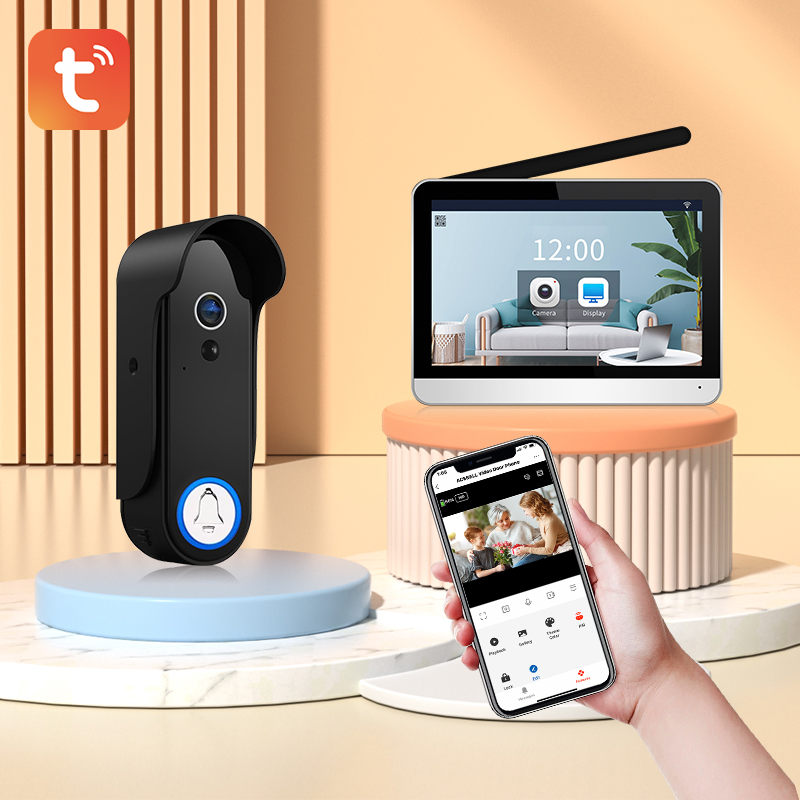智能无线可视门铃:触摸屏技术深度解析
Time:2024-04-15 13:44:48 Views:54次
Introduction: With the rapid advancement of technology, smart wireless video doorbells have become an essential component of modern home security. In this field, the application of touchscreen technology is gradually becoming the mainstream trend. This article will delve into the principles, advantages, and disadvantages of two main touchscreen technologies—surface acoustic wave touchscreens and projected capacitive touchscreens—in smart wireless video doorbells. Through specific examples, we will demonstrate their effectiveness and application scenarios in practical use, and finally, provide a comprehensive outlook on future trends.
Surface Acoustic Wave Touchscreen in Smart Wireless Video Doorbells:
Principle: Surface acoustic wave touchscreens emit sound waves on a sensor board and determine the touch position by receiving the reflected sound waves. When a user touches the screen, the sound waves are obstructed or altered, and the sensor can detect these changes to determine the touch position.
Advantages: Surface acoustic wave touchscreens have high sensitivity and reliability, accurately identifying touch positions. Due to the absence of physical contact, they have higher durability, effectively reducing wear and tear on the touchscreen.
Disadvantages: This technology is susceptible to external interference and contamination. Environmental factors such as surrounding noise or vibrations may interfere with the propagation of sound waves, leading to inaccuracies in touch positions. Additionally, contamination or debris on the surface can affect the normal operation of the sensor.
Case Example: For instance, a homeowner uses a smart wireless video doorbell at night to monitor their doorstep. Through the surface acoustic wave touchscreen, they can easily operate the device and observe clear images, ensuring home security.
Projected Capacitive Touchscreen in Smart Wireless Video Doorbells:
Principle: Projected capacitive touchscreens detect touch positions using capacitive plates and sensors. When touched, the capacitance of the plate changes, and the sensor can detect these changes to determine the touch position. They are typically equipped with a backlight for projecting images onto the touch surface.
Advantages: This technology offers high sensitivity, supports multi-touch, and provides optimized visual effects. The touchscreen responds quickly, ensuring a smooth user experience. Due to the absence of physical pressure during touch, they have a longer lifespan.
Disadvantages: Projected capacitive touchscreens have higher costs and require specialized equipment and technology for implementation. In some cases, they may be sensitive to electromagnetic interference and require shielding.
Case Example: For example, a busy homeowner uses a smart wireless video doorbell during the day. Through the projected capacitive touchscreen, they can easily perform multi-touch operations and observe clear images, ensuring home security.
Future Outlook: With the continuous advancement of smart technology and touchscreen technology, the future prospects of smart wireless video doorbells are promising. Future doorbell systems may further integrate advanced technologies such as artificial intelligence and voice recognition to achieve a more intelligent and user-friendly interaction experience. Additionally, with the widespread adoption of 5G technology and the development of the Internet of Things (IoT), smart doorbells may be more closely integrated with other smart home devices, providing users with a more convenient and secure lifestyle.
Conclusion: Touchscreen technology, as a key component of smart wireless video doorbells, plays a crucial role in enhancing user experience and home security. Understanding its principles and characteristics and selecting the appropriate touchscreen technology is essential for the design and functionality implementation of smart doorbells. In the future, with continuous technological innovation and application, touchscreen technology will continue to bring more possibilities and development opportunities to the field of smart homes.
Chinese Website——http://www.dgjiasong.com

NEXT:智能无线可视门铃:家庭安全的智能守护者
PREV:智能门铃的数据安全保护与加密技术